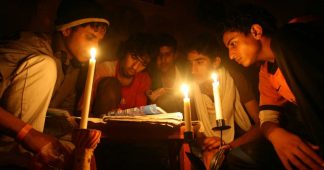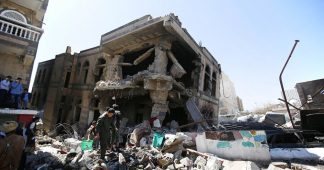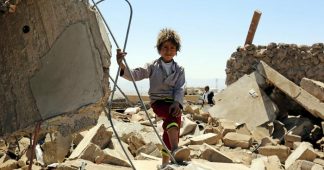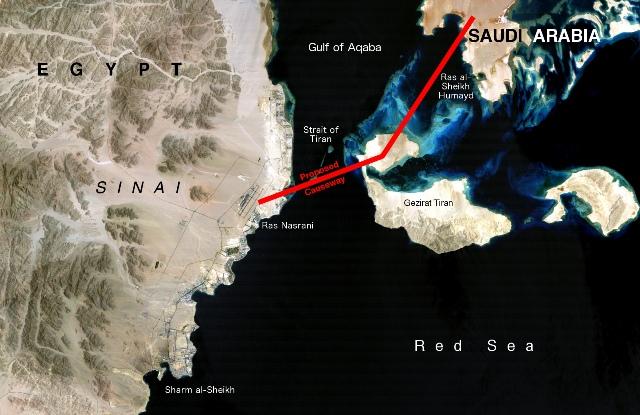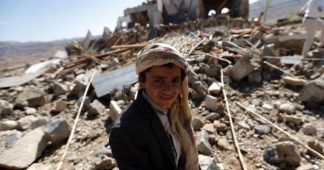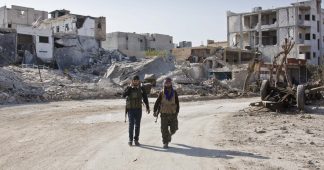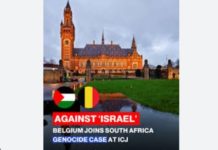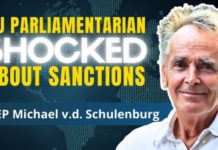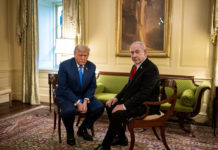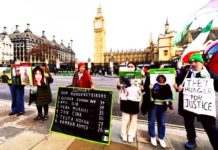Confidential U.N. Document Questions the Saudi Arabian Blockade That’s Starving Yemen
A U.N. panel of experts found that Saudi Arabia is purposefully obstructing the delivery of humanitarian aid into Yemen and called into question its public rationale for a blockade that could push millions into famine. In the assessment, made in a confidential brief and sent to diplomats on November 10, members of the Security Council-appointed panel said they had seen no evidence to support Saudi Arabia’s claims that short-range ballistic missiles have been transferred to Yemeni rebels in violation of Security Council resolutions.
“The Panel finds that imposition of access restrictions is another attempt by the Saudi Arabia-led coalition to use paragraph 14 of resolution 2216 (2015) as justification for obstructing the delivery of commodities that are essentially civilian in nature,” the U.N. experts wrote. Resolution 2216 was passed in April 2015, a month after the Saudi-led international coalition began its intervention in Yemen’s civil war. Paragraph 14 calls for U.N. member states to take measures to prevent the supply, sale, or transfer of military goods to a rebel alliance led by a group called the Houthis, which is backed to an unclear degree by Saudi Arabia’s regional rival, Iran. The panel of experts was established by a previous 2014 resolution and expanded to five members by resolution 2216.
The Saudi-led coalition began enforcing a total blockade of Yemen after a ballistic missile was launched from Yemen at Saudi Arabia’s capital airport on November 4. The coalition, which has the backing of the U.S., said the ratcheted-up blockade was necessary to prevent weapons sent by Iran from reaching the Houthis and their allies, who are loyal to former Yemeni President Ali Abdullah Saleh.
After the blockade was put in place November 6, U.N. humanitarian chief Mark Lowcock told the Security Council that the restrictions on aid to Yemen would result in “a famine killing millions of people, the likes of which the world has not seen for many decades.” This week, Saudi Arabia played down the situation. “There is no embargo,” said Saudi Ambassador to the U.N. Abdallah al-Mouallimi. “There are many sources of supply to Yemen.” On Monday, the Saudi Coalition said they would reopen several ports that had been cut off within 24 hours — but only those in areas already under the coalition’s control. Ports in Houthi-controlled areas were not on the list; ports along the Red Sea at Hudaydah and Saleef, through which nearly 80 percent of imports travel into Yemen, including the bulk of humanitarian aid, were not slated to open.
The Saudis said that before access to all ports is reinstated, the U.N. cargo inspection mechanism known as the U.N. Verification and Inspection Mechanism for Yemen, or UNVIM, would have to be augmented to include the monitoring of smaller boats. However, even large ships with aid cargos that are already inspected by UNVIM are being held up, while the smaller ships that Saudi Arabia says pose a threat will for now presumably be subject to the same scrutiny as before. On Thursday, the U.N. again called for an immediate end to the blockade — even in its reduced form — though it remains unclear how the impasse will be resolved.
According to the most recent U.N. figures, the embargo has blocked 29 ships — carrying roughly 300,000 metric tons of food and 192,000 metric tons of fuel — from reaching Yemen. The U.N. has repeatedly warned that some 7 million people in Yemen are now on the verge of starvation. Yemen is also in the throes of a cholera epidemic that has infected more than 900,000 people. Though the number of new cases has decreased for eight weeks running, U.N. officials say the epidemic will “flare up again” if the embargo is not lifted. A U.N. boat holding more than 1,300 metric tons of “health, wash, and nutritional supplies” is currently stopped short of docking at a port in Hudaydah.
The U.N. experts’ panel brief was delivered prior to the opening of Yemen’s southern ports, but its other notable conclusion was the explicit questioning of evidence presented by the Saudi-led coalition that the missile fired on November 4 was connected to Iran. This allegation was used to justify the ensuing blockade. The coalition, the panel noted, has cited a separate July 22 missile attack which it said used a Qiam-1 short-range ballistic missile of Iranian provenance.
“The supporting evidence provided in these briefings is far below that required to attribute this attack to a Qiam-1 SRBM,” wrote the panel. “The Saudi-Arabia led coalition has not yet though attributed the attempted attack against KKIA” — King Khalid International Airport, in the Saudi capital Riyadh — “to any particular type of SRBM.”
“The Panel has seen no evidence to support claims of SRBM having been transferred to the Houthi-Saleh alliance from external sources in violation of paragraph 14 of resolution 2216,” the brief went on. “Analysis of the supply route options by land, sea or air identifies that any shipments of the large containers used to ship and protect the missiles in transit would stand a very high chance of being interdicted in transit by the Saudi-Arabia-led [sic] coalition forces or the Combined Maritime Forces naval forces deployed in the region. No such interdictions have been reported to the Committee in accordance with the requirement to report arms or arms related material seizures in accordance with paragraph 17 of resolution 2216.”
The panel, however, only has access to evidence that members states are willing to share. In the report, it recommended that Saudi Arabia share additional technical data and asked that the council approach Riyadh for full access to “all SRBM fragments recovered.” On November 10, Lt. Gen. Jeffrey L. Harrigian, the top U.S. Air Force official in the Middle East, also claimed that the missile had “Iranian markings” but did not provide more evidence. A report in Reuters this August alleged that Iran’s Revolutionary Guards were employing a new route in the ocean between Kuwait and Iran to circumvent the arms embargo.
The Yemeni military, the panel added, retained existing stockpiles of SCUD-B and Hwasong-6 missiles that were not completely destroyed by earlier Saudi airstrikes. The panel cite a Houthi spokesperson who said missiles that had been damaged were subsequently repaired and modified. “The panel has not discounted though that Yemen based foreign missile specialists may be providing advice,” the brief cautioned. The panel raised the possibility that missiles may have been altered to extend their range to reach targets farther into Saudi Arabia. Panel members were investigating a shipment of “industrial process equipment, which almost certainly originated in the Islamic Republic of Iran, and may be related to the production of the oxidizer used in the liquid bi-propellants of SRBM rocket motors. Part of the shipment consisted of corrosion resistant storage tanks virtually identical to those used to support SCUD SRBM operations.”
The panel of experts also concluded that the Houthi missile attacks were as much to aid their own morale as to inflict losses on Saudi Arabia. “The primary purpose of the Houthi-Saleh missile force is not to cause substantive military damage to Saudi Arabia, but to directly support a sophisticated strategic media operations campaign,” they wrote.
Some U.N. and aid officials that spoke with The Intercept this week said it seemed Yemeni ports in places like Aden had only been closed — and then announced as reopened — as cover for the continued strangulation of what are actually Yemen’s most vital points of entry. The U.N.’s Office for the Coordination of Humanitarian Affairs this week underscored the importance of these northern ports: “Approximately 71 percent of the people in need in Yemen, and 82 percent of all cholera cases (as of 31 October) are located in areas controlled by the authorities in the north part of the country and in close proximity to these ports,” the U.N. office wrote in an alert released Monday. The U.N. panel of experts has also documented the Houthis obstructing the flow of aid and profiting from the sale of fuel on the black market.
In a statement this week, the Saudi government said it would be “preparing proposals for the ongoing operation of Hodeida port and Sanaa airport,” Yemen’s primary airport. Since last summer, the airport has only been used for humanitarian flights, with commercial access cut off by the Saudi-led coalition. “The airport is critical to get supplies in,” said one Security Council diplomat, who asked for anonymity in order to discuss ongoing council matters. “There are a bunch of UNHAS air flights” — from the U.N.’s humanitarian air service — “that are standing packed waiting to fly in.” On Tuesday, the Saudis bombed the airport twice, damaging its communication equipment.
Five months into the Saudi-led campaign, coalition bombs rendered four cranes used to offload cargo at the Hudaydah port inoperable. The coalition then refused to let the U.N.’s World Food Program install temporary replacements, the acquisition of which had been financed by the U.S. up until this month, Hudaydah’s diminished capacity was already a major cause of shipping delays, in addition to those imposed by the coalition itself. This year, Human Rights Watch reported that in at least seven instances between May and September, the coalition “arbitrarily diverted or delayed fuel tankers headed for ports under Houthi-Saleh control.” One of the ships laden with fuel was held up for over five months.
In February 2016, Saudi officials dispatched letters to both the U.N. and humanitarian organizations operating in Yemen instructing them to leave areas not under the coalition’s control. This would have obstructed aid from reaching most Yemenis. Though Saudi Arabia later walked back the language, humanitarian officials said it had a chilling effect.
A month after the notes were sent, in March 2016, the Security Council began to consider drafting a new resolution focused on humanitarian access and protection of civilians in Yemen. With the idea of a new text under consideration, the Saudi ambassador, Mouallimi, held a press conference in which he bizarrely relayed that senior U.N. aid officials had said such intervention was necessary. Later, it emerged that members of the Gulf Cooperation Council held meetings around this time with officials from France, the U.K., and the U.S. — the permanent members of the Security Council hailing from Western countries. A resolution headlining humanitarian access never materialized. Last week, the Security Council saw the circulation of a statement about Yemen — drafted by the Saudis and circulated by Egypt, another member of the coalition — that made no reference to the humanitarian situation the Security Council had just been warned was of cataclysmic proportions.
“This will likely get worse, given the blockage of vaccines outside the country and potential increases in malnutrition as people struggle to feed their families. So we can confidently say that more children will likely die if this continues for much longer,” said Samir Elhawary, a senior U.N. humanitarian official based in Yemen. If U.N. partners that distribute nutritional assistance cannot resupply over the next month, he said, “80,000 children with severe acute malnutrition are at risk of losing their lives.”
On other occasions in the course of its war, the Saudi-led coalition has taken deliberate action that stymied the delivery of humanitarian aid. In August 2016 — a year after it bombed the cranes at the port — coalition jets repeatedly bombed the main bridge used to carry goods from Hudaydah to Sana’a, and across which 90 percent of U.N. World Food Program aid traveled. The bridge was destroyed despite its presence on a U.S.-provided no-strike list.
Top photo: Yemenis take part in a demonstration calling for the Saudi-led coalition’s blockade to be lifted, on Nov. 13, 2017, in the rebel-held capital Sana’a.
